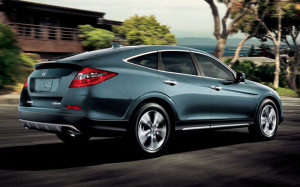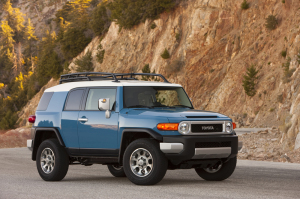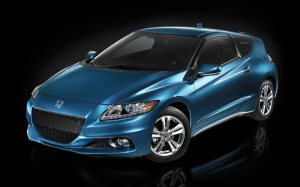There haven’t been many changes from 2012 in the ugly car arena. The industry seems to be recovering its collective sense of style; the major new introductions and redesigns for 2013 aren’t that bad. That said, a lot of ugly cars remain on the market. I have removed two cars from the list—the Scion iQ and Mitsubishi i-MiEV. They drop-off because they sell in such low volume that I haven’t actually seen more than one or two ‘in the wild’ all year . . . they are still ugly though. In their place, the Toyota Prius makes its triumphant return, and the Honda Crosstour graces the list for the first time. The Nissan Murano CrossCabriolet also drops off, since a 2013 model has not yet been announced. It’s still ugly too, but the Kia Soul returns to the list in its place.
The criteria for inclusion is the same it has always been. I don’t include models that aren’t sold in the United States. I don’t include models that sell in low volume (and volume is defined completely subjectively based on how many I see on the highways in the Washington, DC, metropolitan area). I don’t include exotic, military, or special-purpose vehicles—so no super-cars, tanks, or postal trucks. It’s based entirely on my personal opinion of what looks good and what doesn’t.
I encourage your comments—whether they be nominations of ugly cars I may have missed, or impassioned defenses of the ones I didn’t. Feel free to vent your buyer’s remorse here too, if you happen to have purchased one of these monstrosities ;-).
The List
-
Kia Soul

2013 Kia Soul Kia, like its big sibling Hyundai, has come a long way in the last decade. Korean cars used to be a joke, and now they consistently hold their own against their Japanese, European, and American competition—and they do it at a lower price point. The Soul is probably a nice little car, and it generally gets good reviews. But it is a prime example of the old adage that the harder you try to be ‘hip’ and ‘trendy,’ the less ‘hip’ and ‘trendy’ you actually are. The Soul is obviously just a small econo-box, but Kia tried desperately to make it seem young and edgy. It didn’t work. Now it just looks like a really ugly econo-box. I still really enjoy the hamster advertisements, but they aren’t enough to save the Soul from its own sheet-metal.
-
Honda Crosstour

2013 Honda Crosstour The Crosstour began life as a wagon/hatchback variant of the Honda Accord . . . in fact, it was originally branded as the Accord Crosstour. From the beginning, its appearance has been justifiably criticized. It has higher ground clearance than the Accord sedan, which makes it look a bit more like a crossover, but it’s really just an Accord with the ugliness setting on +50 percent. Honda supposedly refreshed the design of the Crosstour for 2013, but I’m hard-pressed to see any significant difference at all. It’s still a misshapen monstrosity that isn’t quite a car, isn’t quite a crossover, and isn’t quite attractive. And thanks to Honda’s legendary reliability, our highways will be blighted with Crosstours for decades to come even if they get discontinued tomorrow.
-
Toyota Prius

2013 Toyota Prius Most ugly cars emerge from the bowels of the automakers’ design offices, land on the market with a thud, and disappear a few years later to be forgotten by a grateful public. Not so with the Prius, which has been ugly since its introduction in 1997, and has remained ugly through two complete redesigns . . . and yet nearly three million people have bought them world-wide. The ugliness is actually part of Toyota’s strategy. The Prius is meant for hard-nosed environmentalists who want everybody around them to know how much they love the Earth, and how much self-respect and driving pleasure they are willing to sacrifice on its behalf. Hybrids do make some sense as a stop-gap until hydrogen fuel cells catch on, but there are plenty of better choices on the market.
-
Honda Insight

2013 Honda Insight The Insight isn’t actually uglier than Toyota’s Prius . . . in fact, they ought to be tied on this list. But Honda’s shameless rip-off of the Prius comes out slightly ahead only because it is, indeed, a shameless rip-off. I understand that companies make ugly cars now and then, but I’ll never understand why any company would look at another company’s ugly car and say, yeah, let’s make an exact copy of that. The good news is that the Honda sells a mere fraction as many Insights as Toyota does Priuses—people who want to buy an ugly cheese-wedge hybrid seem to be opting for the original. But there still are a fair number of Insights out there. They assault the senses just as much as the Priuses do, and then ice the cake with their complete lack of originality.
-
Toyota FJ Cruiser

2013 Toyota FJ Cruiser The Toyota FJ40 was a rugged, tough SUV that competed directly with the Jeep CJ series (which later became the Wrangler). You don’t see them very often in the United States, but I did know a guy back in high school who had one, and it was a bare-bones workhorse that could hold its own against similar compact off-roaders. Toyota intended the FJ Cruiser to be the FJ40’s modern replacement, and it does indeed maintain its 4×4 chops . . . but where Jeep’s Wrangler still looks like a tough off-roader, the FJ Cruiser looks like a plasticized imitation. Its development code name was RYU—the Rugged Youth Utility. Like so many cars from so many manufacturers, explicitly targeting ‘youth’ and trying to be ‘edgy’ backfired terribly. It’s not youthful. It’s not edgy. It’s trying too hard.
-
Smart Fortwo

2013 Smart Fortwo Smart’s freeway-legal golf cart has always been inexplicable. For city-dwellers, they would be better-served by a motor-scooter (at a fraction of the price). For suburbanites, bigger and more practical econo-boxes—like the Nissan Versa, Honda Fit, Toyota Yaris, and others—can be had for nearly the same price. And worst of all, it’s just a weird, ugly little car. The fact that Daimler thought it needed to name the entire brand ‘Smart’ tells us that they didn’t think it was very smart at all. They were trying to convince us, and themselves, that it was a good idea. BMW’s Mini division has proved that there is a market for compact city-cars in the United States . . . but they also proved that they have to be practical, and they have to look really good. Daimler has missed the mark on both counts.
-
Honda CR-Z

2013 Honda CR-Z With the CR-Z, Honda attempted to create a fuel efficient hybrid that looked and drove like a sports car—a ‘sports car without guilt.’ That might have made sense if the people who like sports car tended to feel guilty about driving them. Supposedly Honda developed the driving dynamics of the CR-Z by aspiring to the Lotus Elise, the Mini, and the Volkswagen Scirocco . . . which all well and good, but those cars look great, and the CR-Z doesn’t. Sports cars are supposed to be a joy to drive, and a joy to look at. The CR-Z, however, incorporates the worst design elements from across Honda’s model line and mashes them all together into a repulsive little package. When are automakers going to learn that affordable hybrids don’t have to be ugly? You’re not going to lose the sanctimonious environmentalists by making an attractive car, but you might gain the whole rest of the market.
-
Mini Coupe

2013 Mini Coupe BMW has been working hard to expand Mini’s footprint, and so far they’ve done a pretty good job. They offer a variety of stylish, fun-to-drive compact cars. Even their four-door Countryman crossover manages to be a practical family car that only loses a little bit of the brand’s style and performance. But what on Earth were they thinking when they designed the Coupe? You lose the Hardtop’s back seats and [already limited] storage space, and add a whopping spoonful of ugly. That horrific, misshapen roof-line combined with with the comedy of errors around the rear windows and ‘active’ spoiler earns the Coupe a spot as one of the ugliest cars on the road today. The Coupe’s existence is inexplicable, since the whole rest of the Mini product line is loaded with personality and style. It’s even more inexplicable that anybody goes to a Mini showroom and, among all the options, picks this one.
-
Nissan Cube

2013 Nissan Cube Most Nissans are reasonably attractive, well-made vehicles. There are some odd styling cues here-and-there, but nothing too offensive. But when Nissan decides to make an ugly car, they go all-out. The Cube is a lumpy, rounded, asymmetrical affront to all that is good and decent in automotive design. The fact that it is named for a three-dimensional shape that is squared and symmetrical just adds insult to injury. Much like the Kia Soul, the Cube is a low-end econo-box that was obviously designed in a desperate effort to appeal to young, trendy drivers. And, like the Soul, it fails miserably. But the Cube, quite unlike the Soul, manages not only to miss the mark, but to completely offend the most basic rule of automotive design: make one side look like the other.
-
Nissan Juke

2013 Nissan Juke When Nissan first introduced the Cube to the U.S. market in 2009, I figured it would be on the top of this list for years and years. Then, two years later, Nissan gave us the Juke. As I said, when Nissan decides to make on ugly car, they go all-out. This bug-eyed, frog-like monstrosity is really beyond explanation. It’s hard to imagine what the designers at Nissan were thinking, or why the executives didn’t stop them, or why they decided to produce it, or why anybody buys it. It’s shaped like a crossover, sized like a compact, but costs nearly as much as a mid-sized sedan (like the Altima) or crossover (like the Rogue). Just spend a bit more and get something else, anything else, and leave this thing on the dealer lot as a warning to future generations.
Dishonorable Mention
-
American Suzuki Motor Corporation

American Suzuki Motor Corporation Suzuki is the fourth largest Japanese automaker, lagging behind only Toyota, Honda, and Nissan. It is larger than Mazda, larger than Mitsubishi, and larger than Subaru. You don’t get that big if you don’t know what you’re doing. And yet, here in the United States, they are an abject failure. American Suzuki Motor Corporation, the U.S. division of Suzuki, announced in November that they would be filing for Chapter 11 bankruptcy and would stop selling cars in the U.S. market.
It’s not much of a surprise that Suzukis weren’t selling in the U.S., considering that their product line here has been lackluster and derivative. The Kizashi mid-size sedan was a bland entry in a vibrant part of the market. The SX4 sedan and mini-crossover were uninspired and over-priced in the subcompact market. The Grand Vitara was an aging design up against much more modern mid-size crossovers. And the Equator pickup was nothing more than a less-attractive re-badged Nissan Frontier. Up until 2008, Suzuki was selling the Forenza compact and Verona mid-sized sedans—which were both re-branded Daewoos imported from South Korea. Keeping ancient designs on life-support and slapping your logos on other companies’ cars is not a recipe for long-term success.
When a company as big and successful as Suzuki can’t manage to make a profit in the large and diverse U.S. automotive market—a market that has plenty of room for quirky, niche manufacturers—it deserves a dishonorable mention.

